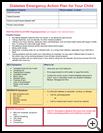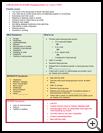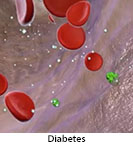
Metabolic Syndrome
______________________________________________________________________
KEY POINTS
- Metabolic syndrome is a common and serious medical problem that increases your child’s risk of heart disease, stroke, and diabetes.
- Treatment includes healthy lifestyle changes such as losing weight, eating a healthy diet, quitting smoking, and exercise. Your child may need medicine to help control blood pressure, blood sugar, and cholesterol.
- Ask your child’s healthcare provider what symptoms or problems you should watch for and what to do if your child has them.
________________________________________________________________________
What is metabolic syndrome?
Metabolic syndrome is a condition that increases the risk of heart disease, stroke, and diabetes. It is a very common and serious medical problem. If metabolic syndrome is not treated, your child is much more likely to have a heart attack, stroke, or diabetes. Decreasing your child’s risk factors by making healthy lifestyle changes can help prevent these health problems.
Your child may be diagnosed with metabolic syndrome if he or she has 3 or more of the following risk factors:
- Excess weight (fat) around the waist
- High levels of triglycerides in the blood
- Low HDL cholesterol levels
- High blood pressure based on your child’s age and per your child’s healthcare provider
- A fasting blood sugar (glucose) higher than normal
What is the cause?
The exact cause is not known. The risk is higher if your child:
- Has a family history of type 2 diabetes, high blood pressure, high cholesterol, or heart disease
- Doesn't get enough physical activity
- Is overweight
- Smokes
- Eats a diet high in unhealthy fats or simple carbohydrates
What are the symptoms?
Your child may not have any symptoms. Medical problems that come from metabolic syndrome develop over time. If your child does have symptoms, they may include:
- Headaches
- Getting tired easily
- Blurred vision
- Dizziness
- Urinating a lot
- Increased thirst
- Increased hunger
How is it diagnosed?
Your healthcare provider will ask about your child’s symptoms and medical history and examine your child. Your child will have blood tests to measure:
- Triglycerides
- HDL cholesterol
- Blood sugar
How is it treated?
The most important part of treatment is making healthy lifestyle changes:
- More physical activity as recommended by your healthcare provider will help your child improve fitness, lose weight, and lower blood pressure, triglycerides, and blood sugar. Physical activity also raises HDL, the “good” cholesterol.
- A healthier diet
- Not smoking
If lifestyle changes don’t lower your child’s risk enough, your healthcare provider may prescribe medicine. Your child may need to take more than one medicine, such as:
- Blood pressure medicines can lower your child’s blood pressure and help prevent stroke and heart damage.
- Cholesterol medicine can bring down high triglyceride levels. It can also raise HDL, or "good" cholesterol, levels. If your child smokes, quitting will also raise HDL.
- Medicines can help lower your child’s blood sugar levels.
How can I take care of my child?
It is possible to prevent or delay metabolic syndrome, mainly with lifestyle changes. A healthy lifestyle is a lifelong commitment.
Follow the full course of treatment prescribed by your healthcare provider. In addition, make sure that your child:
- Eats a diet low in saturated fat, trans fat, and simple carbohydrates such as candy, sugar, and baked goods. Avoids foods and drinks that are high in added sugar. For example, your child should drink water instead of sugary drinks, such as soda.
- Gets more exercise, especially aerobic exercise. Ask your provider to give you a physical activity plan that tells you what kind of activity, and how much, is safe for your child. It’s best if your child starts slowly to avoid injury.
- Doesn’t smoke and avoids secondhand smoke. Smoking lowers HDL and increases the risk for heart disease in other ways as well.
- Loses weight if overweight and keeps a healthy weight. Even just a 10% weight loss may help lower cholesterol, blood sugar, and blood pressure.
- Has cholesterol levels, blood sugar, and weight checked as often as recommended by your healthcare provider.
Ask your provider:
- How and when you will get your child’s test results
- If there are activities your child should avoid and when he or she can return to normal activities
- How to take care of your child at home
- What symptoms or problems you should watch for and what to do if your child has them
Make sure you know when your child should come back for a checkup. Keep all appointments for provider visits or tests.
Last modified: 2016-11-23
Last reviewed: 2016-11-09



